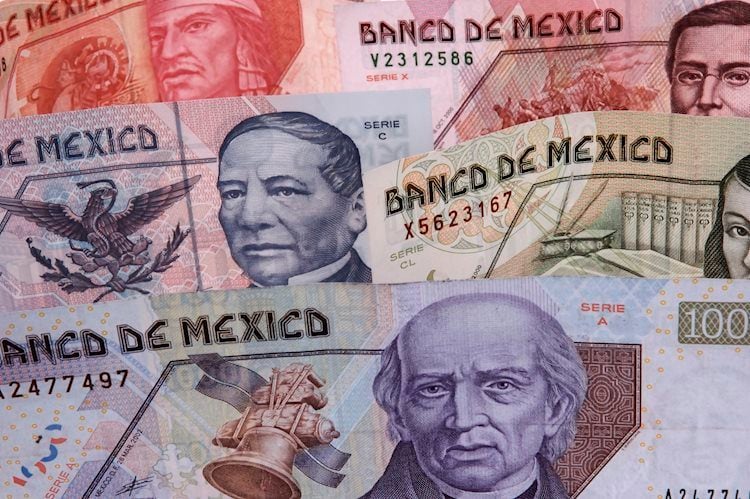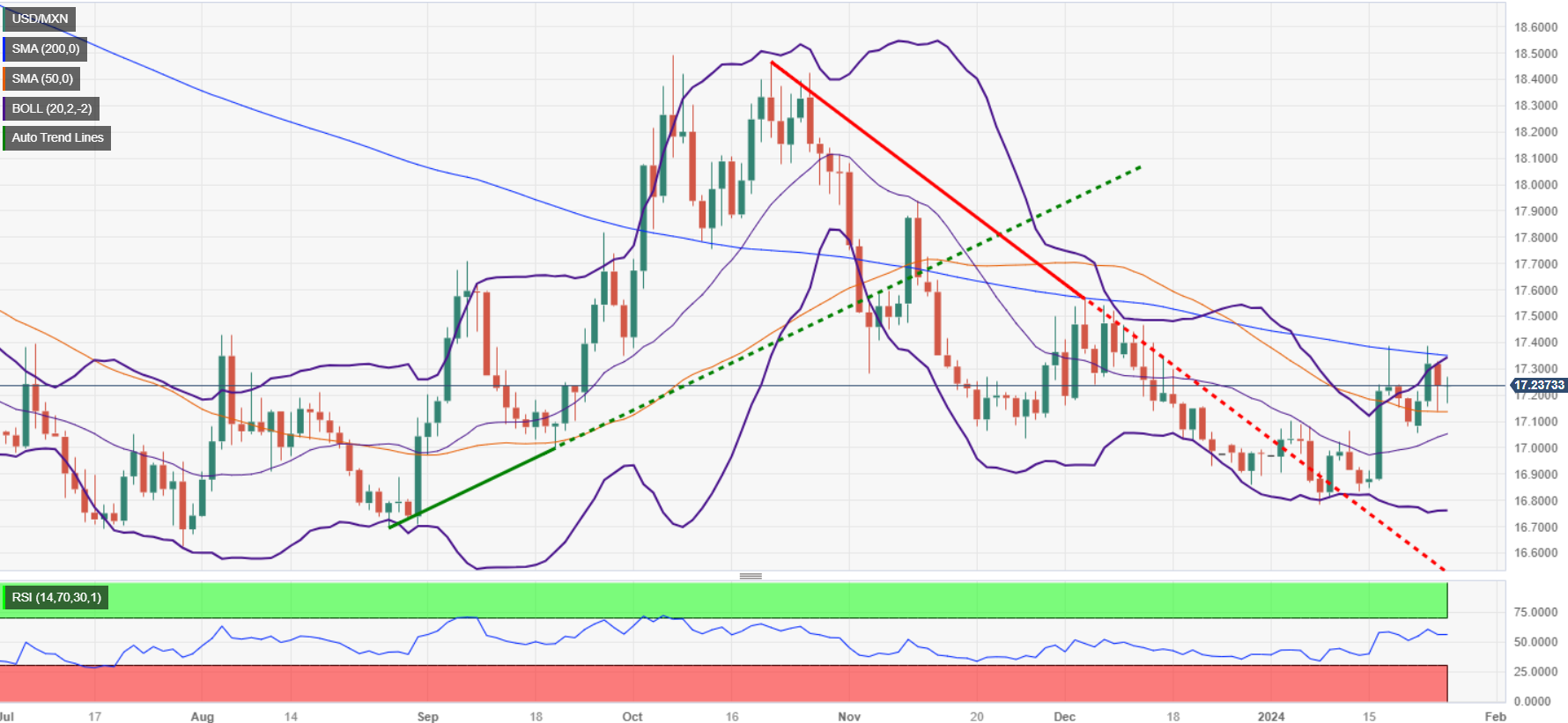- Mexican Peso drops 0.08% amidst US economic data showing continued growth and mixed signals from Mexico.
- Strong US GDP growth for Q4 2023 and stable Durable Goods Orders could impact Fed’s rate decisions, contrasting with a cooling labor market.
- In Mexico, a lower unemployment rate and rising inflation pose challenges for Banxico’s policy direction.
The Mexican Peso (MXN) registers minuscule losses against the US Dollar (USD) on Thursday after economic data from the United States (US) witnessed the economy continuing to grow above trend, though below last year’s Q3 4.9% final reading. In the meantime, Mexico’s unemployment rate continued to trend lower at a non-seasonally adjusted rate, along with an uptick in inflation in the first half of January, boosting the emerging market currency. At the time of writing, the USD/MXN trades at 17.22, up 0.08% on the day.
The economy in the US remains solid, growing above trend, and might prevent interest rate cuts by the Federal Reserve (Fed) amid a possible reacceleration of inflation. The Gross Domestic Product (GDP) for the last quarter of 2023 exceeded forecasts, while Durable Goods Orders were unchanged and the labor market showed signs of cooling down.
In Mexico, the Unemployment Rate was non-seasonally adjusted for December and dipped compared to November, revealed the National Statistics Agency (INEGI). Meanwhile, according to analysts at BNP Paribas, the latest inflation report in Mexico could deter the Bank of Mexico (Banxico) from easing policy.
Daily Digest Market Movers: Mexican Peso at cross-roads following solid US data
- US GDP for Q4 2023 rose by 3.3% QoQ, smashing estimates of 2%, but less than Q3’s 4.9% increase, according to the US Bureau of Economic Analysis . In 2023, Real GDP rose by 2.5%, sponsored by “increases in consumer spending, nonresidential fixed investment, state and local government spending, exports, and federal government spending,” revealed the report.
- The US Department of Commerce revealed Durable Goods Orders were unchanged in December, with figures clocking 0%, lower than November’s 5.5% rise due to a slump in transportation equipment manufacturing.
- The US Bureau of Labor Statistics reported that for the week concluding on January 20, Initial Jobless Claims rose to 214K, surpassing both the prior week’s figures and the projected 200K.
- The Unemployment Rate in Mexico slowed from 2.7% to 2.6% in December as expected by analysts.
- In Mexico, mid-month inflation increased by 0.49%, which was higher than the anticipated 0.38% but lower than December’s 0.59%. Meanwhile, core prices matched expectations at 0.25%, showing a decrease from December’s 0.46%.
- Annually, general inflation in Mexico rose 4.9%, above forecasts, and the prior month’s 4.46%, while core inflation cooled from 5.19% to 4.78%, as foreseen.
- Economic Activity in November shrank -0.5% on a monthly basis, lower than forecasts and October’s -0.1% contraction. Annual figures dropped from 4.2% to 2.3%, below forecasts of 3.2% growth.
- The economy in Mexico is beginning to show the impact of high rates set by Banxico at 11.25%, even though most analysts estimate the economy will grow above 2% in 2024. Nevertheless, retail sales missing estimates, the economy growing below 3% in November, and inflation reaccelerating puts a stagflationary scenario in play.
- Pamela Diaz Loubet, Economist for Mexico at BNP Paribas, commented that the outlook for Banxico’s Governing Council is complicated and full of risks. She added that economic activity remains solid, implying that higher interest rates at 11.25% had not yet affected growth and are uncertain to do so. She estimates Mexico’s economy in 2023 grew 3.5%, though it should drop to 2.5% this year.
- Traders trimmed their bets for a dovish Federal Reserve in 2024. They stand at 139 basis points (bps) of cuts from 175 bps last week.
- Despite indications from the December meeting minutes of Banxico (the Central Bank of Mexico) that it may consider easing its monetary policy, the inflation report for January poses a potential obstacle to any such policy relaxation.
- Standard Chartered analysts estimate the Bank of Mexico (Banxico) will lower rates to 9.25% in 2024.
- On January 5, a Reuters poll suggested the Mexican Peso could weaken 5.4% to 18.00 per US Dollar in the 12 months following December.
Technical Analysis: Mexican Peso stays firm as USD/MXN hovers around 17.24
The USD/MXN is virtually unchanged, though trading within familiar levels. If the exotic pair reclaims the 200-day Simple Moving Average (SMA) at 17.35, that could open the door for the pair to challenge the 100-day SMA at 17.42. Further upside is seen above the psychological 17.50 figure, ahead of rallying to the May 23 high from last year at 17.99.
Conversely, if sellers drag prices below the 50-day SMA at 17.13, that would pave the way for further downside. The following support is seen at 17.05, the January 22 low, followed by the 17.00 psychological figure.
USD/MXN Price Action – Daily Chart
Mexican Peso FAQs
The Mexican Peso (MXN) is the most traded currency among its Latin American peers. Its value is broadly determined by the performance of the Mexican economy, the country’s central bank’s policy, the amount of foreign investment in the country and even the levels of remittances sent by Mexicans who live abroad, particularly in the United States. Geopolitical trends can also move MXN: for example, the process of nearshoring – or the decision by some firms to relocate manufacturing capacity and supply chains closer to their home countries – is also seen as a catalyst for the Mexican currency as the country is considered a key manufacturing hub in the American continent. Another catalyst for MXN is Oil prices as Mexico is a key exporter of the commodity.
The main objective of Mexico’s central bank, also known as Banxico, is to maintain inflation at low and stable levels (at or close to its target of 3%, the midpoint in a tolerance band of between 2% and 4%). To this end, the bank sets an appropriate level of interest rates. When inflation is too high, Banxico will attempt to tame it by raising interest rates, making it more expensive for households and businesses to borrow money, thus cooling demand and the overall economy. Higher interest rates are generally positive for the Mexican Peso (MXN) as they lead to higher yields, making the country a more attractive place for investors. On the contrary, lower interest rates tend to weaken MXN.
Macroeconomic data releases are key to assess the state of the economy and can have an impact on the Mexican Peso (MXN) valuation. A strong Mexican economy, based on high economic growth, low unemployment and high confidence is good for MXN. Not only does it attract more foreign investment but it may encourage the Bank of Mexico (Banxico) to increase interest rates, particularly if this strength comes together with elevated inflation. However, if economic data is weak, MXN is likely to depreciate.
As an emerging-market currency, the Mexican Peso (MXN) tends to strive during risk-on periods, or when investors perceive that broader market risks are low and thus are eager to engage with investments that carry a higher risk. Conversely, MXN tends to weaken at times of market turbulence or economic uncertainty as investors tend to sell higher-risk assets and flee to the more-stable safe havens.

